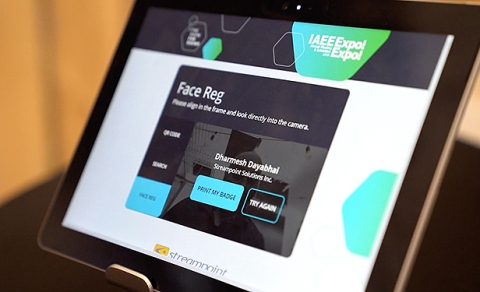FaceReg Promises to Reduce Wait Times for On-Site Check-In

There’s a whole new component coming to face-to-face events, with “face” being the key factor. Facial recognition for on-site check-in is slowly gaining traction, with more registration suppliers adding the technology to their portfolios.
Launched at IAEE’s Expo! Expo! in Las Vegas in Dec. 2019, registration and housing provider Streampoint Solutions’ FaceReg promises to reduce wait times for on-site check-in.
Dharmesh Dayabhai, Streampoint Solutions’ co-founder, says that the time from face detection to badge print is around 3-5 seconds. “The time savings is due to not trying to locate the QR code, or having to search and print your name,” he explains.
An added benefit, he adds, is reducing stress. As registration is attendees’ first interaction point on-site, having a seamless check-in experience sets a positive tone for the event.
Attendees are presented with options to scan their face at the registration area. With a simple click of a button, their face is recognized and their badge is printed.
“The goal is to keep the workflow as simple as possible to provide a large audience adoption,'' says Dayabhai. “The attendee has to simply upload their image during the registration process and/or during their badge verification process. This step is optional, as considerations have to be made for folks who do not wish to upload their images.”
Thirty-five percent of Expo! Expo! attendees chose to try FaceReg. Streampoint officials believe this percentage will increase across the events industry as the technology is more widely adopted and attendees understand the secure nature of the solution.
Dayabhai says that Streampoint Solutions takes privacy and security very seriously. “Only the client and the project manager have access to their data from the back office,” he explains. “Once the event is completed, the photo data and the photo is deleted from the system.”
For attendees who choose to not opt-in, check-in would be conducted by the more traditional registration routes: via barcode or QR code scan; self-check-in via name search on a terminal then presenting an ID to pick up the printed badge, or speaking with an onsite registration agent for badge printing.
Dayabhai says that FaceReg can be set up anywhere provided internet connectivity exists. Streampoint will create its own network to ensure security, uptime and backups.
As far as group size goes, Dayabhai states the solution is extremely scalable. “There is no real limit — it can work for smaller to larger events with a simple deployment from our end.”
Sam Louie, Streampoint Solutions’ director of operations, says that facial recognition is becoming mainstream. “Investing in this technology in the event space opens the doors to not only advancing the check-in process but also creates new opportunities to enhance audience engagement experiences,” he explains.
There are a number of other ways facial recognition technology might be used at events in the future, including streamlining session check-in, payments, social media, event security and more — perhaps even eliminating the need for data entry during the initial registration process. Data collected from various checkpoints could fuel back-end analytics, helping event organizers develop more personalized, engaging experiences for their audiences.
Dayabhai is coy about potential future applications, saying only that Streampoint is exploring other uses and will reveal new use cases in due time.
FaceReg is currently available with Streampoint Solutions’ registration platform. The company will offer the solution at an introductory rate for clients holding events in 2020 that submit their RFPs prior to March 2020.
See a short video of FaceReg in action HERE. For more information, contact sales@streampoint.com.
Don’t miss any event-related news: Sign up for our weekly e-newsletter HERE and engage with us on Twitter, Facebook, LinkedIn and Instagram!


Add new comment